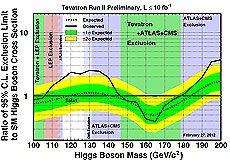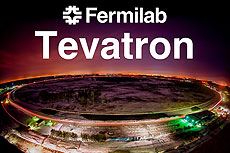Exciting hints of Higgs boson in the Tevatron data

If the entire Tevatron Run II program was repeated a hundred times and the Higgs boson did not exist, then the observed limit at each mass point would fall within the green band 68 times and within the yellow band 95 times.
The decades long hunt for the Higgs boson might be soon over. The first results using the Tevatron's full data set show tantalizing hints of what the future might bring. The Higgs boson is the only fundamental particle predicted by the Standard Model that has not been observed.
Finding the Higgs boson would validate a key aspect of the Standard Model - the use of the Higgs mechanism to generate the masses of the weak force carriers. The Higgs field would also explain why quarks and charged leptons have mass. A sensitive search that rules out the existence of the Higgs boson would indicate that new physics must exist to explain particle masses and may herald the start of an exciting era of discovery. Either result from the search for the Higgs boson, observation or exclusion, will mark a turning point in the road for the field of high energy physics.
The Standard Model does not predict the mass of the Higgs boson, but does dictate its behavior for a given mass. While the Higgs boson favors decaying into a pair of b quarks below a mass of 135 GeV/c2 and a pair of W bosons above that mass, CDF and DZero scientists exploit all possible decay modes in their search. Each search channel is optimized to discriminate its type of Higgs boson candidate events from its particular combination of backgrounds.

The CDF and DZero collaborations thank AD, PPD and CD for the important fundamental contributions they have made to our physics program and we acknowledge support from many national and international funding agencies, especially the U.S. DOE and the NSF.
CDF and DZero scientists examine the Tevatron data for extra events above the expected background that are consistent with Higgs boson production. This yields an upper limit for the amount of Higgs boson production that is allowed by the data. That limit is quoted at the 95 percent confidence level, such that there is only a one in twenty chance the Higgs boson exists with a higher production rate than the limit. If the limit for a given Higgs boson mass is below the Standard Model production rate, that mass point is excluded at the 95 percent confidence level.
When CDF and DZero scientists look at the data, they find they cannot exclude the Higgs boson in the full mass range accessible at Tevatron due to an excess of data beyond the background expectation in the mass region 115 GeV/c2 to 135 GeV/c2. The 2.2 sigma excess leaves little chance that the observed data is consistent with the background expectation in this region. While this broad excess is consistent with Standard Model Higgs boson production, and consistent with the excess reported by the LHC experiments in different decay channels, this excess does not carry enough statistical significance to be evidence for Higgs boson production. Evidence is only claimed if there is a 3 sigma excess in the observed data above the background expectation.
In the coming months, scientists at CDF and DZero will further refine their analysis techniques and increase their combined sensitivity to a Higgs boson signal. The Tevatron data shows intriguing hints of where the hunt for the Higgs boson might lead, but the search is not over yet!
—Mike Cooke and Ben Kilminster
|